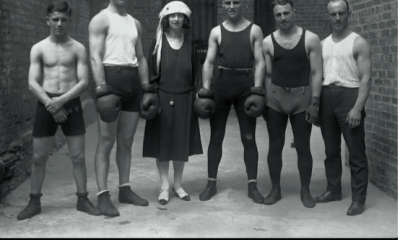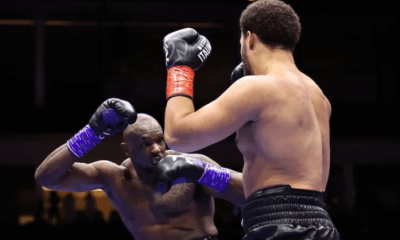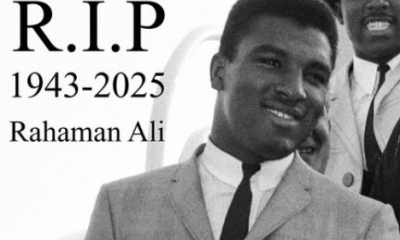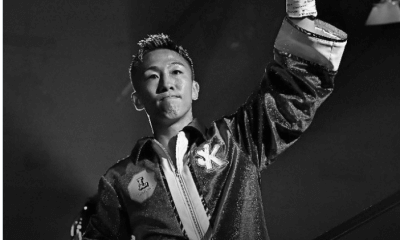Articles of 2005
Boxing History From Round One
Men have been hitting each other in the face for as long as there have been faces to hit, and if it wasn’t over this bone or that, then it was just for the fun of it.
Six-thousand year old hieroglyphs from ancient Egypt profile men engaged in the manly art. According to Scholiast on Pindar, in 900 B.C. Theseus, son the Greek monarch Aegeus, introduced boxing to his soldiers as a way to kill time. The men would wrap their hands in leather, sit on large stones in the hot sun, and pound each other to death.
The classical Greeks, who honored athleticism along with art and intellect, brought boxing into the big-time at the XXIII Greek Olympiad in 688 B.C. The Olympics were founded by Oxylos a hundred years earlier, in 776 B.C., as an athletic festival to honor Zeus, king of the gods. The festivities lasted five days and were held at Olympia in the Peloponnesos every four years. Those Olympics excluded team sports in lieu of individual achievement and included discus and javelin throwing, the long jump, running, wrestling and the pentathlon, in addition to horse and chariot races. Given the high-toned company, it’s no surprise that boxing fit in as well as it did.
That was a turning point in the realm of fistiana. Boxing was finally legit. The world’s first champion was Onamastus of Smyrna and he was crowned with a wreath of olive branches. The earliest written record we have of boxing came from Homer in the 23rd book of The Illiad. In the 8th century B.C. he put his pen to paper, his quill to parchment, and gave the world its first fight coverage. Homer wrote of a tussle in 1184 B.C. during the Fall of Troy between Epeus, king of a tribe from the Peloponnesian Peninsula, and Euryalus, son of King Mecisteus. They fought at the funeral games of Petrocles, in a fight promoted by Achilles. The stakes were high, as usual, even for contests of this sort. Not only was the two men’s honor at stake. There were exotic prizes.
The winner won a mule. The loser got a drinking cup.
How did Homer call it?
Amid the circle now each champion stands,
And poises high in the air his iron hands,
With clashing gauntlets now they fiercely close,
Their crackling jaws re-echo to the blows,
And painful sweat from all their members flows,
At length Epeus dealt a weighty blow
Full on the cheek of his unwary foe.
There’s nothing like a one-punch knockout to set the record straight.
Boxing in ancient Greece wasn’t that different from boxing today. The combatants trained in gymnasiums, as modern boxers do, with a regimen of calisthenics, diet, shadowboxing and roadwork. They practiced their punching on speedbags filled with fig seeds and grain. They performed in stadiums. There was no clinching, hooks or uppercuts in those days. There were no rounds, decisions or TKOs. These refinements were still to come. The fight was over when one of the fighters could fight no more.
He admitted defeat by raising his index finger.
In some ways that was the last gasp of civilized behavior vis-à-vis the fistic arts for many years. The pancratium was introduced at the 38th Olympiad. Like boxing in one respect, the pancratium permitted punching, but the pancratium also allowed wrestling, tripping, kicking, stomping, hair pulling and strangulation. By upping the ante in such a manner, the good old Greeks – in anticipation of the Romans – were traveling that long and winding road from heavenly heaven to hellish hell, and the crowd, as crowds often do, ate it up.
Art from that time depicts a lively interest in pugilism. A Minoan vase from Cyprus from 1600 B.C. called Boxing Rython shows two cartoon characters sparring. A Greek urn from Rhodes circa the 6th century B.C. depicts four men at a boxing match: two boxers going at it, with a chief second on the right to offer assistance, and a ref on the left holding a stick with which to enforce the rules. There is a bronze statue in Rome’s National Museum from the late Hellenistic period of a seated pugilist. His smashed nose, misshapen lips and cauliflower ears attest to a profession like no other.
Greece fell to the Romans in 146 A.D. The Holy Roman Empire was in full swing by then, and when the Romans got their hands on boxing they would not let go. The Romans introduced the sport at the Games in the Colosseum. The Colosseum held 50,000 fans and featured such time-honored activities as chariot races, animal hunts, sea battles, gladiators fighting to the death, and that all-time crowd favorite, feeding Christians to the lions. Among such fiendish amusements, the simplicity of two men fighting with bare fists had to be jazzed up to satisfy the Romans’ bloodlust.
Because the fighters were either slaves or convicted criminals or prisoners of war, the Romans could do pretty much with their captives as they liked, so the Romans created the caestus, hard leather gloves that covered the hands, wrists and forearms, and into which metal studs, teeth and spikes were inserted. Boxing and the Roman Colosseum were now a perfect fit. The phrase “killer punch” took on a whole new meaning.
The Roman poet Virgil in his Aeneid from the 1st century A.D. wrote rhapsodically about the caestus.
From somewhere he produced the gloves of Eryx
And tossed them into the ring, all stiff and heavy,
Seven layers of hide and insewn lead and iron.
You can still see the blood and splash of brains
That stained them long ago.
A century later, a Latin poet named Lucilius wrote about a fighter’s misshapen mug: “Having such a face, Olympicus, go not to a fountain nor look into any transparent water, for you, like Narcissus, seeing your face clearly, will die, hating yourself to death.” Lucilius also wrote in his Epigrams: “Onesimus the boxer came to the prophet Olympus wishing to learn if he was going to live to an old age. And he said, Yes, if you give up the ring now, but if you go on boxing, Saturn isn’t in your horoscope.”
Men were men and nothing less in the misty vistas of ancient Rome, but gents in Asia were also fighting. The East, home to most of the martial arts, also had their variations on boxing: vajra-musti in India, as recounted in the early Hindu epic poem Mahabharata, shaolin boxing in China, muay-thai in Thailand and bama letwhay in Burma. But Imperial Rome set a standard for the western world, and boxing rose and fell with the Holy Roman Empire. After twelve centuries of blood on the sand, Theodosius I abolished boxing in 393 A.D. For thirteen hundred years, with a few notable pockets of resistance in Europe, there were no formal fights.
The Brits in Regency England in the late 1600s woke boxing from its slumber. In tune with the Restoration, the English resurrected the game as a way to divert rabble in a town square. Boxing was right at home with the cockfights, dogfights, the bull and bear baiting, the ratting and farting contests. Boxing softened up the crowd for the public lashings of whores and Roman Catholics.
The diary of Samuel Pepys has an entry from August 1660 that refers to a fight between a Dutchman and a waterman at the stairs of Westminster Abbey. In another entry from 1662 Pepys wrote: “I came and saw my first prizefight . . . between one Mathews . . . and one Westwicke who was cut several times in head and legs . . . all over blood . . . strange to see what a deal of money is flung to them both between every bout.” The Protestant Mercury from January 1681 recorded a fight of note: “Yesterday, a match of Boxing was performed before His Grace, the Duke of Albemarle, between the Duke’s footman and a butcher. The latter won the prize, as he hath done many times before, being accounted, though a little man, the best at the exercise in England.”
It wasn’t long before a wily gent saw that boxing had potential. That man was James Figg. He was a master of the broadsword, cudgel and quarterstaff, and embraced bareknuckle prizefighting as a legitimate form of self-defense. Figg opened his amphitheater – history’s first boxing gym/casino – on Tottenham Court Road in 1719. Figg was as much of a showman as he was a pugilist, and his daily challenge to the crowd was: “For money, for love, or a bellyful!” Figg had many students eager to learn the noble art. One of these students, Captain Godfrey, wrote boxing’s first how-to book in 1740 and titled it A Treatise on the Useful Science of Defense. He never forgot the lessons he learned at Figg’s Academy: “I purchased my knowledge with many a broken head and bruises in every part of me.”
Figg’s greatest pupil was a heavyweight named Jack Broughton. Not only was he big. He was also athletic. The “Father of Boxing” could parry and cross-buttock throw. He introduced defense. He created counterpunching. Broughton was boxing’s first ring genius and he ushered in 170 years of hard-hitting bareknuckle history.
In 1743, under the patronage of William, Duke of Cumberland, Broughton opened his amphitheater. One of his fights was against a Yorkshire coachman named George Stevenson. Broughton beat up Stevenson so badly that he died three days later. Broughton was crestfallen at the death, but Broughton believed in boxing, so he created Broughton’s Rules, the first modern rules, published on August 16, 1743. These rules introduced the referee and forbid gouging and kicking a man when he was down.
Broughton was a great champion and when he lost the crown in 1750 boxing went into a tailspin. But boxing was not going away. The first Anglo-American war fought by men with their fists was between England’s champion Tom Cribb and a former slave from the United States named Bill Richmond in 1805. Cribb fought another tough black man from a southern plantation named Tom Molineaux in 1810 and 1811. Also during this time, Pierce Egan’s Boxiana (1812), the first great book devoted exclusively to boxing, introduced the “sweet science of bruising” to eternity.
Boxing in England was the thing. Champs like Daniel Mendoza, Richard Humphries, Gentleman John Jackson, Jem Belcher, Tom Spring, Jem Mace and Tom Sayers were the stars of the day. These were men who could protect themselves at all times and at all times look good doing it.
The London Prize Ring Rules were introduced in 1838 and further legitimized the game. These rules gave us the boxing ring, and outlawed biting, butting and wearing spiked boots.
The Marquis of Queensberry Rules of 1867 established 3-minute rounds with 1-minute rest periods, and boxing gloves became the norm, signaling a melancholy end to the bareknuckle era.
In the twentieth century the United States became the dominant force in the fight game. The heavyweight reign of the Great John L. Sullivan, the Boston Strong Boy, who won the last bare-knuckle heavyweight title in 1882, gave way to legendary fighters named Jim Corbett in 1892, Jim Jeffries in 1899, and Jack Johnson, the first great heavyweight of the modern era, in 1908.
The heavyweight eras of Dempsey, Louis, Marciano, Ali, Holmes, Tyson, Holyfield and Lewis carry us through the last century and into our own. Boxing was here before we were and will be here after we’re gone. Boxing has legs. Boxing has a good chin. Boxing is here to stay.
-

 Featured Articles3 weeks ago
Featured Articles3 weeks agoThe Hauser Report: Cinematic and Literary Notes
-

 Featured Articles4 weeks ago
Featured Articles4 weeks agoOscar Duarte and Regis Prograis Prevail on an Action-Packed Fight Card in Chicago
-

 Book Review3 weeks ago
Book Review3 weeks agoMark Kriegel’s New Book About Mike Tyson is a Must-Read
-

 Featured Articles1 week ago
Featured Articles1 week agoThe Hauser Report: Debunking Two Myths and Other Notes
-

 Featured Articles2 weeks ago
Featured Articles2 weeks agoMoses Itauma Continues his Rapid Rise; Steamrolls Dillian Whyte in Riyadh
-

 Featured Articles4 weeks ago
Featured Articles4 weeks agoRahaman Ali (1943-2025)
-

 Featured Articles4 weeks ago
Featured Articles4 weeks agoTop Rank Boxing is in Limbo, but that Hasn’t Benched Robert Garcia’s Up-and-Comers
-

 Featured Articles3 weeks ago
Featured Articles3 weeks agoKotari and Urakawa – Two Fatalities on the Same Card in Japan: Boxing’s Darkest Day














